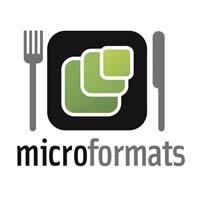Microformats, snack of the semantic web

Unlike the semantic web, microformats are not an initiative of the World Wide Web or of the W3C organization that leads the future of the network and its director and inventor of the web, Sir Tim Berners Lee, but a movement emerged between Internet users. But it is not an initiative contrary to the semantic web; the aim of the microformats is to advance in the same idea while it arrives.
Inserted in current HTML web
The semantic web proposes the construction of a parallel network, encoded in structured formats of representation of the meaning, in which all objects, people, etc. are described. that are mentioned in the other and their relationships. In the movement of microformats only certain concepts, the most used and practical, and within the current web in HTML, are labeled semantically. For this purpose, generic tags and attributes with HTML formats are used: div label (used to differentiate the different sections of the page), span tag (used to highlight the parts of a text), class attribute (used to describe the type of element in which it is treated) and rel attribute (used to define the type of relationship in the relation elements). Thus, a microformat is defined by assigning to these labels certain values of class and rel attributes.
Through the CSS style sheets we can get this code seen by the user as any web page, but when the information is structured, the machines can understand the content.
Multi-purpose microformats

The movement of microformats is not a standard definition entity, but an open community that is coordinated through the web http://microformats.org. Your wikis, mailing lists, etc. serve to define microformats, create new, discuss, etc. and thus have defined the existing microformats currently existing.
In this same web you can consult the existing microformats or the proposals in phase of decision. Some of the most important are hCalendar for events, hCard for contact information of people and entities, adr for postal addresses, geo for geographical coordinates, hResume for résumés, hReview, reviews, mentions, comments and scores, hRecipe for recipes, hProduct for product description, VLinks : for poll, rellicense :
Therefore, if we manage a website, we can encode in microformat different aspects of that website (contact information, events calendar, etc. ). We can do this directly in the HTML code or in the programming of the web, but more and more web development tools allow to code the microformats: Drupal, Wordpress, Dreamweaver... And there are validators to see if we have done it well.
Use of microformats
Microformats can have thousands of uses. For example, anyone can easily complete a service that will join the events indicated by hCalendar on various web pages and organize it by fields taking advantage of the geo-format information... Most programming languages have libraries to work with microformats.

In addition, there are already services that use microformats. The main search engines allow to search for free license content thanks to websites that use the microformat rel-license. Google has recently announced that it will detect on web pages the hCard, hReview and hProduct microformats to offer richer search results (Yahoo! For more than a year). And the Firefox browser has a plug-in called Operator that detects microformats on the pages we are browsing and allows us to perform advanced operations: add events to our agenda, automatically enter contact information in our list of addresses, bring a geographic coordinate to our Tagzia account… Soon these options will come directly integrated in the browser.
And there is no doubt that more and more tools and services of this type will be created. Until the arrival of the semantic web, you can taste the power of semantic through microformats.
Buletina
Bidali zure helbide elektronikoa eta jaso asteroko buletina zure sarrera-ontzian











